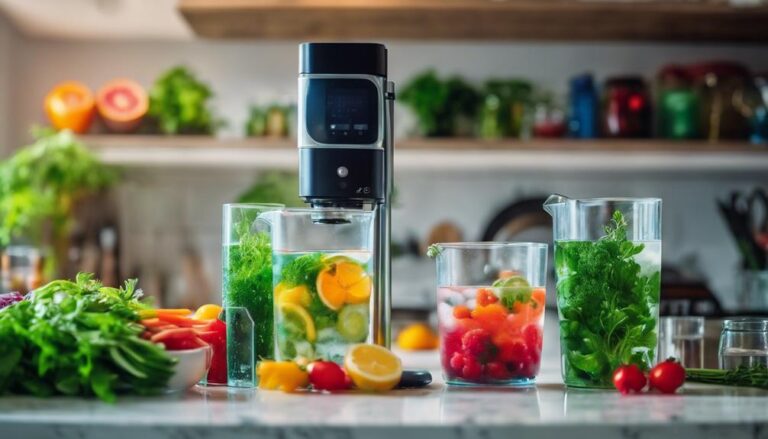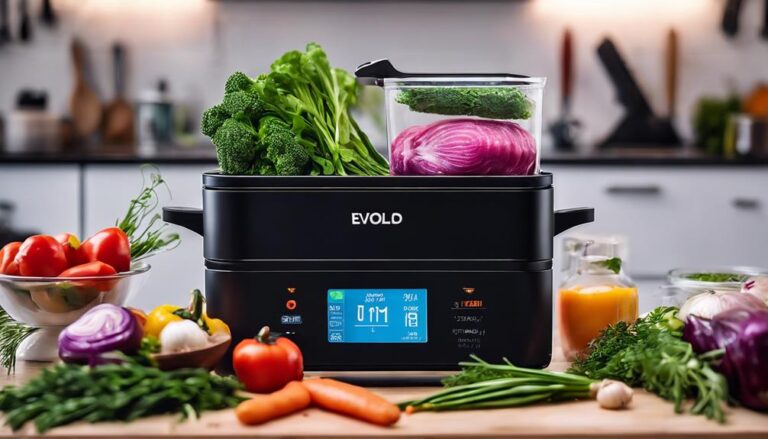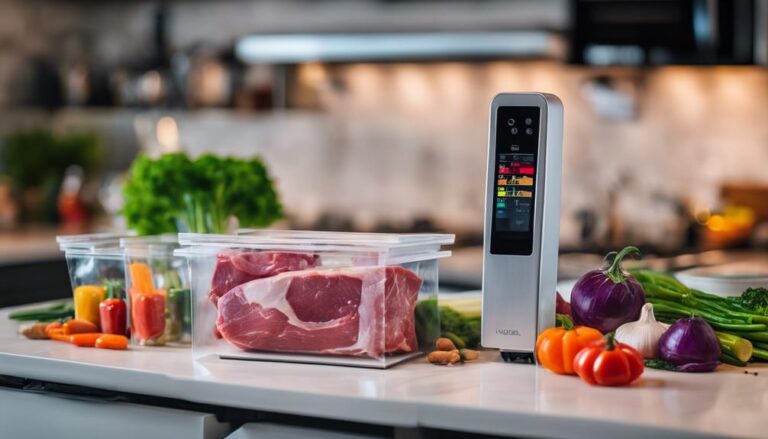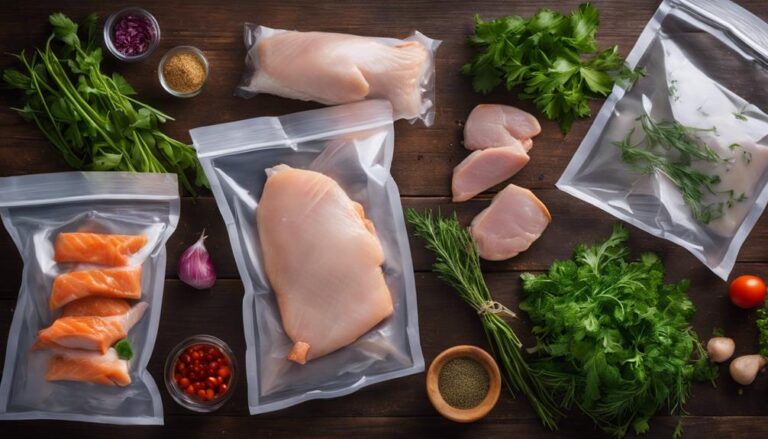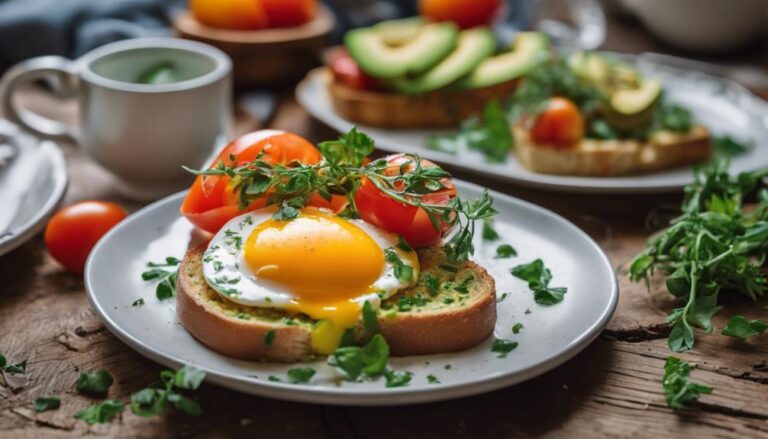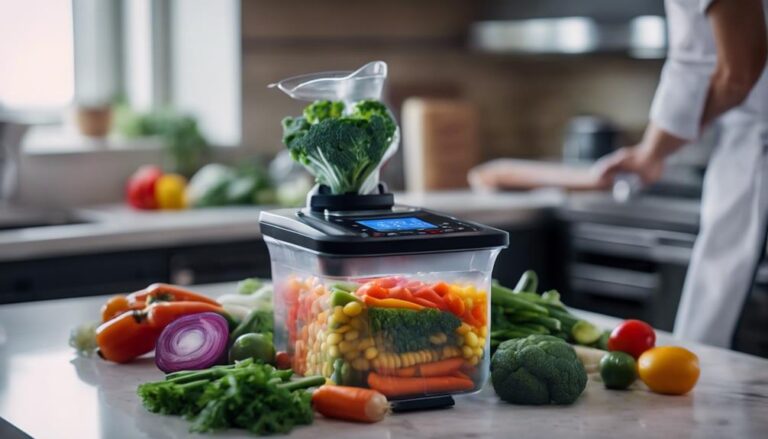Sous Vide Vs. Traditional Cooking: Health Benefits Compared
Sous vide cooking offers significant health benefits compared to traditional cooking methods. It preserves more vitamins and minerals since it uses low temperatures, reducing nutrient loss that usually occurs with high-heat cooking. This method also enhances food safety by eliminating harmful bacteria effectively. Additionally, sous vide locks in moisture and flavor, resulting in juicier, more flavorful meals. With precise temperature control, you can avoid overcooking, ensuring better textures and tenderness. Overall, sous vide stands out for improving nutrient retention and food quality in a health-conscious diet. There's plenty more to discover about this innovative cooking technique.
What You Will Learn Here
- Sous vide cooking preserves more water-soluble vitamins and essential minerals compared to traditional boiling methods, reducing nutrient loss significantly.
- Precise temperature control in sous vide enhances food safety by effectively eliminating harmful bacteria and pathogens.
- Sous vide retains moisture and flavor, resulting in juicier meats and vibrant vegetables with improved texture.
- Cooking times and temperatures in sous vide allow for extended cooking without compromising taste, ensuring consistent results.
Overview of Cooking Methods
When it comes to cooking, you have two main approaches: sous vide, which uses low, controlled temperatures, and traditional methods like boiling, which rely on high heat.
Sous vide cooking involves sealing food in vacuum bags and cooking it at precise temperatures, typically between 65°C to 95°C, for an extended period. This method stands out for its ability to maintain the nutritional value of food, preserving vitamins and minerals that traditional cooking methods often lose.
Conversely, traditional cooking methods expose food to high heat and oxygen, which can considerably reduce nutrient content, particularly in sensitive vitamins. While boiling might cook your food quickly, it risks overcooking and moisture loss, impacting taste and texture.
Temperature control is an essential aspect of sous vide cooking, enabling effective pasteurization and ensuring food safety by eliminating harmful bacteria. In contrast, traditional methods may not always guarantee the same level of safety, as uneven cooking can leave some areas undercooked.
Ultimately, both methods have their merits, but sous vide cooking presents a modern and innovative approach to preparing food while prioritizing nutrition and safety.
Nutrient Retention Comparison
When you compare nutrient retention between sous vide and traditional cooking methods, you'll notice some key differences.
Sous vide cooking excels at preserving vitamins and enhancing mineral content thanks to its precise temperature control.
This method not only helps maintain delicate flavors but also minimizes nutrient loss, making it a healthier choice for your meals.
Vitamin Preservation Techniques
Sous vide cooking excels at preserving water-soluble vitamins like vitamin C and B vitamins, markedly outperforming traditional boiling methods that often lead to substantial nutrient losses. When you use sous vide, you're employing a technique that maintains the nutritional values of your ingredients. Traditional boiling can cause a loss of 20% to 40% of these delicate vitamins due to high temperatures and oxygen exposure.
With sous vide cooking, you achieve controlled temperatures, which minimizes the degradation of these thermolabile vitamins. This precise temperature control not only enhances nutrient retention but also guarantees that the bioavailability of vitamins remains intact. Research supports that cooking food in a sous vide environment can retain more vitamin C and B compared to conventional methods, allowing you to enjoy more nutritious meals.
Moreover, the reduction of harmful oxidative reactions in sous vide cooking further protects these essential vitamins during the cooking process. By choosing sous vide, you're not just cooking; you're innovating your approach to healthy eating, confirming that your meals are both delicious and rich in crucial nutrients.
Mineral Content Enhancement
Mineral content considerably improves with sous vide cooking, often retaining and even enhancing crucial nutrients compared to traditional boiling methods.
When you use the sous vide method, you'll notice an impressive increase in minerals like zinc, iron, potassium, and copper, with some studies showing gains of up to 862 mg for zinc alone. Traditional methods, on the other hand, typically lead to a 20% to 40% loss of these essential nutrients due to prolonged heat treatment.
The sous vide process showcases its nutritional advantages by preserving the mineral concentration in foods. For instance, the ash content in dishes can soar from 260 mg to 1240 mg, demonstrating a significant boost in mineral content. Testing various legumes and cereals reveals that sous vide generally outperforms boiling, yielding higher levels of magnesium, zinc, and copper.
Moreover, because sous vide cooks at lower temperatures with controlled exposure to heat and oxygen, it better maintains thermolabile vitamins and minerals.
This enhanced bioaccessibility of minerals means that meals prepared sous vide can greatly support a nutritious diet, making it an ideal choice for anyone keen on maximizing their nutrient intake.
Cooking Temperature Impact
Cooking at controlled low temperatures in sous vide not only preserves thermolabile vitamins but also enhances nutrient retention compared to traditional high-heat methods. When you choose sous vide cooking, you're making a smart decision for your health.
Here are three key benefits to evaluate:
- Thermolabile Vitamins: Sous vide cooking maintains essential vitamins like vitamin C and B vitamins, which can be lost during high-temperature cooking.
- Mineral Retention: Studies show that sous vide can greatly increase mineral content, enhancing bioaccessibility compared to traditional methods that often lead to a 20% to 40% nutrient loss.
- Protein Quality: This method retains higher amounts of soluble proteins and essential amino acids, improving digestibility and reducing the formation of harmful compounds.
Health and Safety Benefits
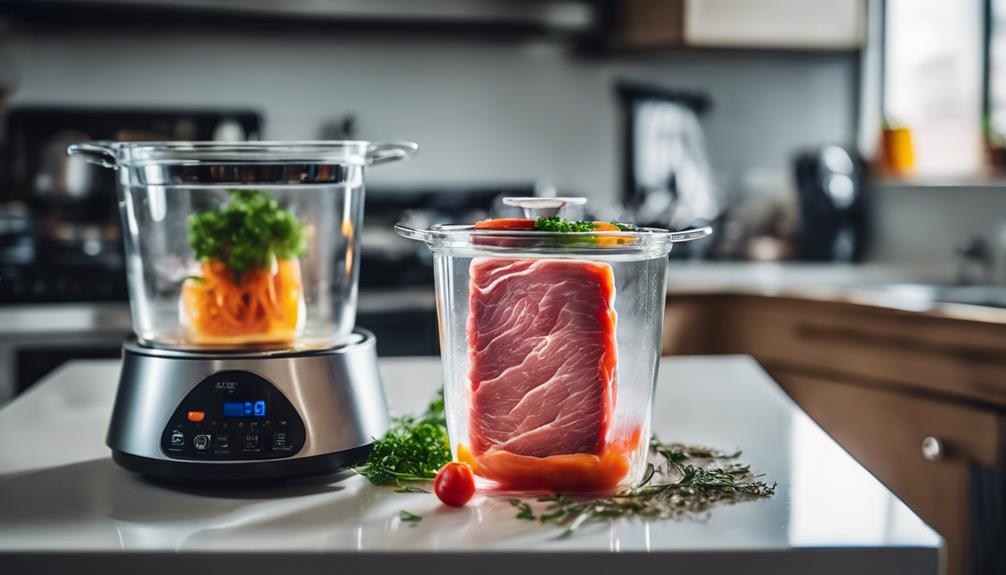
When it comes to health and safety, sous vide cooking offers several advantages over traditional methods.
You can enjoy enhanced food safety through precise temperature control, which helps eliminate harmful bacteria while preserving nutrients.
Plus, the technique minimizes harmful compounds and extends the shelf life of your meals, making it a smart choice for both flavor and well-being.
Nutrient Preservation Techniques
Sous vide cooking effectively preserves essential water-soluble vitamins and minerals, making it a healthier alternative to traditional methods that often lead to considerable nutrient loss.
When you choose sous vide, you're opting for a cooking technique that maintains the nutritional integrity of your food.
Here are three key benefits:
- Higher Vitamin Retention: Sous vide reduces the loss of thermolabile vitamins, which can diminish by 20% to 40% in boiling water.
- Enhanced Mineral Quality: This method greatly boosts mineral content, with increases in zinc, iron, and potassium.
- Controlled Temperature: The precise temperature control guarantees ideal preservation without overcooking, resulting in both safety and quality.
Enhanced Food Safety
Achieving enhanced food safety is one of the standout advantages of sous vide, as it guarantees precise temperature control that effectively eliminates harmful bacteria. When you prepare sous vide meals, you can rest assured that foodborne pathogens, like salmonella, are dealt with properly. This method allows you to cook foods, such as poultry and eggs, at safe temperature ranges that are hard to achieve with traditional cooking.
The vacuum-sealed packaging used in sous vide minimizes exposure to oxygen, which helps prevent the growth of bacteria and oxidation. By pasteurizing your food at specific low temperatures, you create an environment of microbial safety that ensures harmful bacteria are greatly reduced while preserving the integrity of delicate ingredients.
Moreover, chilling the sealed pouches after cooking helps halt any potential bacterial growth, allowing your meals to remain safe for consumption over extended periods. Overall, the controlled cooking environment of sous vide provides a level of microbiological stability that traditional methods may not achieve, especially for high-risk foods.
With sous vide, you're not just cooking; you're innovating your approach to food safety.
Flavor and Texture Retention
One of the key benefits of sous vide cooking is its ability to retain moisture and natural flavors, resulting in juicier meats and vibrant vegetables that traditional methods often leave dry and bland. When you embrace sous vide, you're enhancing your culinary experience with:
- Flavor and Aroma: The vacuum-sealed environment preserves essential oils and compounds, intensifying the natural flavors of your ingredients.
- Texture and Tenderness: Precise temperature control prevents overcooking, maintaining the ideal texture of proteins while ensuring they remain tender and succulent.
- Nutrient Retention: Sous vide minimizes nutrient loss, particularly essential minerals, which can diminish considerably with traditional boiling methods.
This innovative cooking technique not only promotes moisture retention but also reduces oxidation, protecting sensitive compounds that contribute to flavor and nutrition.
By avoiding high-heat methods, you'll minimize harmful compounds like heterocyclic amines (HCAs) and polycyclic aromatic hydrocarbons (PAHs).
Ultimately, sous vide empowers you to create dishes that aren't only delicious but also healthier, allowing the true essence of your ingredients to shine through.
Flavor Enhancement Techniques
The unique cooking method of sous vide seals in moisture and natural juices, resulting in dishes that are more succulent and flavorful than those prepared using traditional techniques.
By utilizing low and slow cooking, you can effectively enhance the flavors of your ingredients without the risk of moisture loss. This method keeps your food tender and juicy, allowing the natural flavors to shine.
Sous-vide cooked dishes benefit from precise temperature control, which optimizes the extraction of flavors from herbs and spices. You won't need excessive oil or heavy seasoning, as the cooking process amplifies the inherent sweetness of fruits and vegetables.
The vibrant flavor profiles achieved through sous vide can often surpass those from conventional boiling or steaming.
Additionally, cooking at lower temperatures minimizes the formation of bitter compounds and off-flavors that can emerge from high-heat methods. This results in a more harmonious taste experience.
Cooking Times and Temperatures
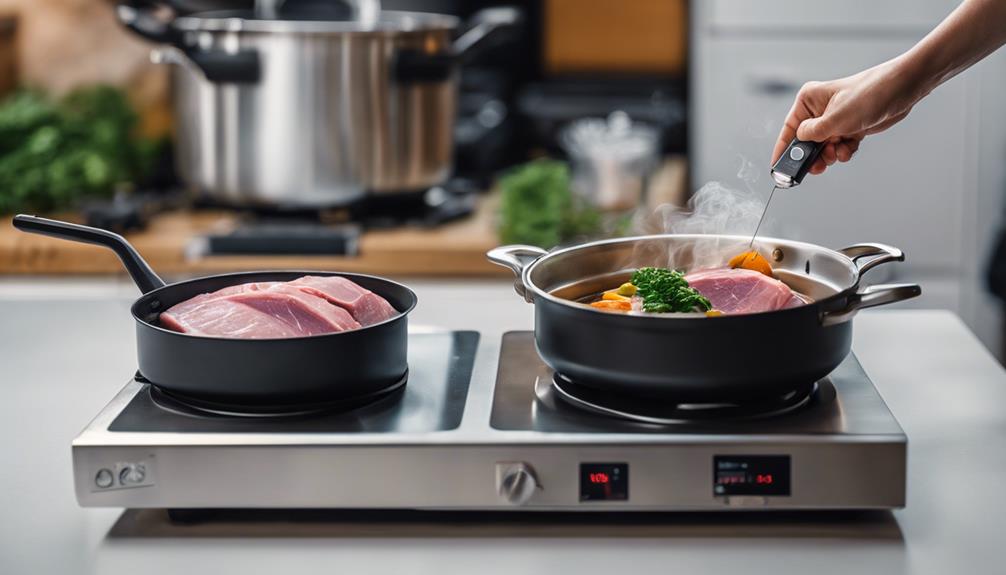
When it comes to cooking times and temperatures, sous vide offers precise control that traditional methods often lack.
You can set your sous vide machine to low temperatures for extended periods, ensuring that your food cooks evenly and retains maximum flavor.
In contrast, traditional cooking typically requires higher temperatures for shorter times, which can sometimes compromise taste and nutrients.
Optimal Temperature Control
Sous vide cooking offers precise temperature control, allowing you to achieve perfect doneness while preserving nutrients and enhancing flavors. This method stands out for its ability to maintain ideal temperature control, which can greatly reduce nutrient loss and improve the quality of your meals.
Here are three key benefits you won't want to overlook:
- Consistent Results: Cooking at controlled temperatures, ranging from 50°C to 90°C, guarantees that your food reaches the desired doneness without overcooking.
- Enhanced Nutrient Retention: Unlike traditional methods that often expose food to high heat, sous vide minimizes nutrient loss, keeping essential vitamins intact.
- Improved Texture: By cooking meat at lower temperatures for extended periods, you can achieve tender structural changes in meat, making even tough cuts enjoyable.
With sous vide, you can set specific cooking times, from just 20 minutes to 48 hours, allowing for flexibility in your kitchen. This innovative approach not only elevates your culinary skills but also promotes healthier eating by maximizing the nutritional value of your ingredients.
Give sous vide a try, and experience the difference in your cooking!
Cooking Time Variability
Cooking time variability in sous vide offers remarkable flexibility, allowing you to customize preparation based on the specific ingredient and your desired level of doneness.
Unlike traditional methods, which often require higher temperatures and shorter cooking times, sous vide enables you to cook foods at precise temperatures for extended periods. For instance, you can prepare beef at 129°F (54°C) for 1-2 hours to achieve a perfect rare finish.
When it comes to tougher cuts of meat, sous vide excels by cooking them at 185°F (85°C) for 8-16 hours. This method effectively breaks down collagen, resulting in tender meat without the risk of overcooking commonly associated with traditional methods.
Plus, sous vide retains moisture and natural flavors, ensuring your meals are juicy and delicious. Additionally, this technique helps preserve sensitive nutrients, as cooking at low temperatures minimizes nutrient loss.
You can enjoy ideal taste and health benefits without excessive cooking times. With sous vide, you have the power to explore innovative cooking time and temperature combinations, achieving perfect results that traditional methods may struggle to deliver.
Consumer Preferences and Trends
Health-conscious consumers are increasingly leaning towards sous vide methods for their ability to preserve nutrients and enhance flavors, aligning with their desire for both taste and quality.
As you explore this innovative cooking technique, consider these key factors driving consumer preferences:
- Nutritional Quality: Sous vide cooking retains more vitamins and minerals compared to traditional methods, ensuring healthier meals.
- Food Safety: The precise temperature control in sous vide cooking minimizes the risk of harmful microbial growth, appealing to those prioritizing safe food preparation.
- Convenience: With the rise of ready-to-eat meals, sous vide offers an efficient way to prepare nutritious dishes without preservatives.
These factors contribute to the growing popularity of sous vide among health-conscious consumers.
As you seek out the latest trends, you'll find that sous vide not only meets the demand for enhanced flavor and texture but also aligns with modern standards for health benefits and food safety.
By adopting sous vide cooking, you can elevate your culinary experience while ensuring your meals are both delicious and nutritious.
Embracing this innovative approach allows you to cater to your health needs without sacrificing taste.
Impact on Food Quality
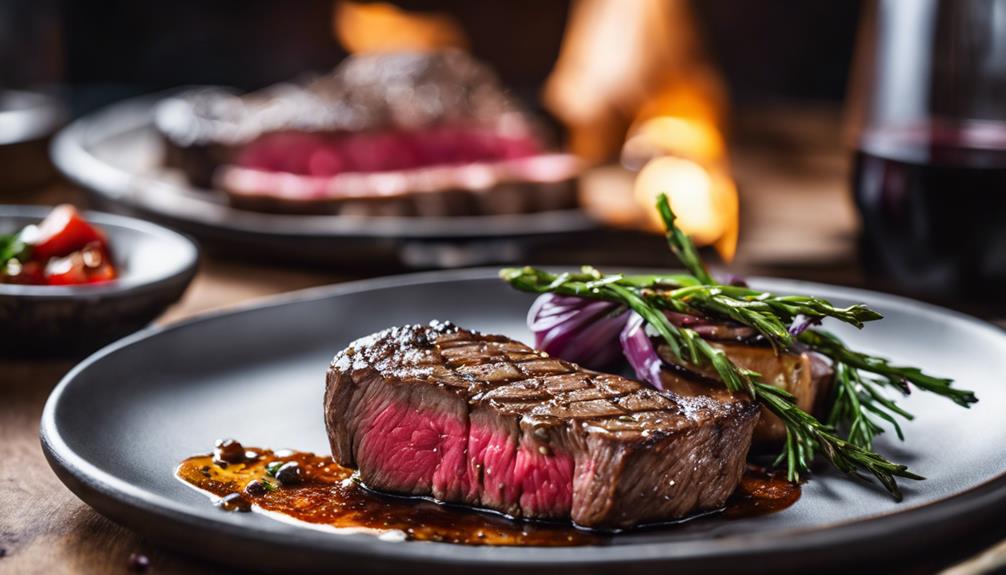
The shift towards sous vide reflects a broader focus on food quality, as this method greatly enhances the nutritional content and taste of meals. By cooking food in a controlled environment at low temperatures, sous vide preserves essential nutrients that traditional cooking methods often diminish. For instance, studies show that sous vide can increase mineral content, such as zinc, iron, and copper, while also reducing the loss of thermolabile vitamins like vitamin C and B vitamins.
This technique seals food in airtight pouches, minimizing oxidation and evaporation, which helps maintain delicate flavors and textures. As a result, you'll experience juicier, more flavorful meats without relying on excess oils or fats. The visual appeal of your dishes also improves, as sous vide preserves vibrant colors that attract the eye.
In addition to enhancing nutritional value, sous vide cooking elevates the overall sensory characteristics of your meals. The combination of preserved nutrients, flavors, and appealing presentation creates a dining experience that's not only enjoyable but also innovative. If you're looking to improve your food quality, sous vide is an excellent cooking method to evaluate.
Sous Vide and Food Preservation
Sous vide offers an impressive method for food preservation, keeping the natural qualities of vegetables and seafood intact while extending their shelf life. This innovative cooking technique provides several benefits:
- Minimized Oxidation: The vacuum-sealed environment reduces exposure to air, slowing down oxidation and preserving flavor.
- Enhanced Food Safety: By limiting microbial growth, sous vide cooking helps maintain a cleaner cooking process.
- Optimal Nutritional Value: Precise temperature control retains essential vitamins and minerals that traditional methods might lose.
Using sous vide not only prolongs shelf life but also enhances the sensory qualities of food. You'll notice that aromas and flavors remain vibrant, making your meals more enjoyable.
This method allows you to cook at lower temperatures, preventing overcooking and ensuring that the texture of your ingredients stays fresh.
Research Findings on Nutritional Value

Research shows that sous vide cooking considerably preserves and enhances the nutritional value of food compared to traditional methods.
When you use sous vide, you can expect a significant reduction in the loss of thermolabile vitamins like vitamin C and B vitamins, with studies indicating up to 40% less loss compared to boiling. This is essential for maintaining a robust nutritional profile.
Moreover, sous vide cooking has been shown to increase mineral content substantially. For instance, you might find increases in zinc, iron, potassium, and copper when comparing sous vide to traditional boiling methods. The ash content, which reflects mineral presence, can rise dramatically, proving the effectiveness of this method.
Additionally, sous vide enhances the bioaccessibility of essential minerals such as calcium, copper, iron, potassium, and magnesium. In contrast, traditional boiling often reduces the bioaccessibility of some minerals, particularly zinc.
Practical Tips for Sous Vide Cooking
To achieve the best results with sous vide cooking, start by using BPA-free vacuum-sealed bags to guarantee your food remains free from harmful chemicals. This innovative cooking method requires attention to detail, including precise time and temperature settings.
Here are three practical tips to enhance your sous vide experience:
- Follow Time and Temperature Guidelines: For example, cook beef at 140°F (60°C) for 6-14 hours to achieve a perfect medium-rare. Adjust these settings based on the thickness of your food for ideal results.
- Maximize Nutrient Retention: When cooking vegetables, aim for temperatures around 185°F (85°C). This method preserves essential vitamins and minerals, giving you healthier meals.
- Chill Quickly After Cooking: To prevent bacterial growth and extend the shelf life of your meals, always cool sealed pouches quickly after cooking. This step is essential for maintaining food safety.
Frequently Asked Questions
Is Sous Vide Cooking Healthier?
Sous vide cooking can be considered healthier due to its focus on sous vide nutrition and cooking precision.
With precise temperature control, you can pasteurize food effectively, enhancing food safety.
This method retains more vitamins and minerals, improving flavor retention while reducing the need for excess oils.
By preventing overcooking, sous vide also delivers juicier proteins with appealing textures.
Which Cooking Method Is the Healthiest for Cooking?
When considering which cooking method is healthiest, sous vide stands out.
It offers superior nutrient retention, preserving more vitamins and minerals compared to traditional methods.
By cooking at controlled temperatures, it enhances food safety, reducing the risk of foodborne illnesses.
Plus, the technique promotes flavor enhancement while minimizing the need for excess oils.
If you want innovative meal prep that prioritizes health, sous vide is a compelling choice for your culinary repertoire.
What Are the Disadvantages of Sous Vide Cooking?
Imagine a world where precision meets patience.
Sous vide cooking, while innovative, has its drawbacks. You'll need specialized sous vide equipment, which can be pricey, and the cooking time is often lengthy, making it impractical for quick meals.
Food safety can be a concern if the temperature or duration isn't just right.
Plus, you might miss out on texture contrast, as sous vide can sometimes sacrifice that delightful crust for flavor retention.
What's the Advantage of Cooking Sous Vide?
Cooking sous vide offers several advantages that enhance your culinary experience.
With precision cooking, you achieve exact temperatures, ensuring food is cooked evenly. This method excels in flavor retention, allowing natural tastes to shine without excessive seasoning.
Additionally, sous vide promotes nutrient preservation, keeping essential vitamins intact during the cooking process.
It's particularly useful for meal prep, giving you consistent results while simplifying complex culinary techniques.
Conclusion
In conclusion, both sous vide and traditional cooking offer unique health benefits, much like two sides of a coin.
Sous vide excels in nutrient retention and food safety, while traditional methods can enhance flavor through techniques like browning.
Understanding these differences helps you make informed choices in the kitchen.
Whether you prefer the precision of sous vide or the familiarity of traditional cooking, each method can contribute to healthier meals and better food quality overall.






